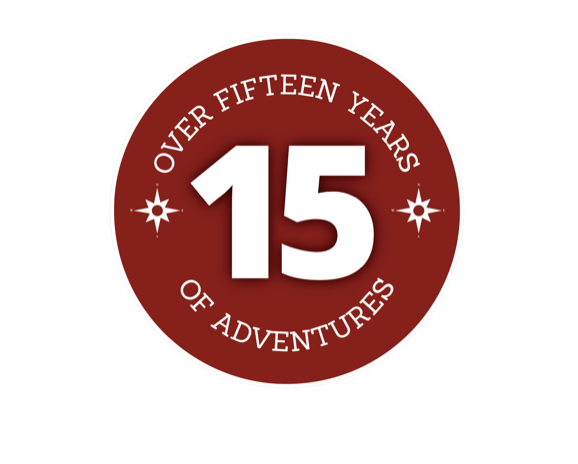We just arrived back in Isafjordur from another great expedition to the remote coast of east Greenland. We left home in the evening of August 4th and immediately set all sail for a great cruise towards the sunset off NW Iceland. Only about 50 miles off the coast we met the first large icebergs that had broken away from the main pack and drifted south-east towards Iceland.
After sailing for only 28 hours we arrived at the entrance to J.A.D. Jensen fjord just north of latitude 68 deg N. This is approximately 200 miles from the nearest human settlement. We sailed into the fjord and stopped at the NW corner of Soekongen island. The weather was absolutely perfect, flat calm and sunny. In the morning we met three hunters from Tasiilaq whe were there on their little motor boat. They were looking for Narwal but had just spotted four Polar-bears a few miles from where we were staying. After a short stay we decided to attempt to sail around Soekongen island and out through Nansen fjord. The great Christian IV glacier calves into this fjord and it was pretty much packed with ice. It took us therefore almost 10 hours to navigate a distance of only 12 miles, zig-zakking out between the ice floes and bergs.
When we made it out of Nansen fjord we decided to head further down along the coast and headed for Mikis Fjord. We arrived in Mikis fjord in the early morning and set anchor at the head of the fjord. This is where we dropped off (and picked up again later) the Scottish/Spanish Gunnbjornsfjeld expedition last year. Again the weather was lovely and the group hiked up the Soedalen valley to where a Danish group has set up a basecamp for mining exploration. We spent a night at this anchorage and the next morning a part of the group kayaked out to the NW corner of Mikis Fjord in perfect weather.
The kayaks were loaded onboard AURORA later in the afternoon and we set course past Cape Hammer and into the great Kangerdlugssuaq fjord. We sailed past impressive mountains on one side and fjord full of ice on the other towards Kraemer island.
This area includes the most impressive mountain ranges in Greenland. The Lemon Mountain range is to the north of Kangerdlugssuaq. This is a vast mountain range with compact alpine peaks. There are endless opportunities for mountaineering with many unclimbed peaks up to 2.600 meters. Many peaks offer excellent mixed climbing with up to 1000m vertical height gain from basecamp to summits. This range includes the Cathedral peak made famous by Chris Bonington and Robin Knox-Johnston when they sailed there on Robin´s yacht Suhaili in 1991 to climb. Further west are the Kangerdlugssuaq mountains which is a huge and extensive region of alpine granite and gneiss peaks up to 2.600m. This is probably the single largest region of unclimbed summits in Greenland and is ideal for easy ski touring exploration. To the north and east are the Watkins mountains with Gunnbjorns Fjeld (3.693m) the highest mountain in the Arctic. Actually this range contains all 10 highest mountains in the Arctic. This is the ultimate Greenland destination for ski-mountaineering on big peaks with up to 1.500m vertical height from basecamp to summits.
We worked our way into Suhaili bugt at Kraemer island. This anchorage was surveyed by sir Robin’s crew in 1991 and was used to keep Suhaili while the climbing expedition were in the mountains. We anchored with one line ashore and spent a quiet night at this very safe anchorage. To the Greenland people, Kangerdlugssuaq apparently has always been regarded as an especially rich hunting ground – a kind of Shangri-La, that can be reached only with difficulty but where life can be expected to be good. Recent endeavours to colonize Kangerdlugssuaq date from 1966 when a number of families from Ammassalik (Tasiilaq) settled there. They had a very good season (35 polarbears, 62 narwhales and about 2100 seals) and returned most years afterwards. We kayaked over to the old abandoned settlement and checked out the ruins.
Our original plan was to work our way south along the coast. According to the latest ice charts there was a large tongue of ice off Kong Christian IX land so we decided to do the trip to the Ammassalik area in one stretch. We headed out of Kangerdlugssuaq fjord and set course south. Around 67degN we hit the pack ice and had to take a de-tour 60 miles off the coast to get around it. After about a day and a half of sailing we arrived in Sermiligaq fjord. This was our seventh day out.
We anchored close to the head of this great fjord. The group headed out on the dinghy towards the Knud Rasmussen glacier. They brought their ice axes with them and had an oportunity to walk a bit on the glacier. After spending a peaceful night at this anchorage we headed off into the Ikateq sound. Half way into the sound are ruins of an abandoned American air-base from second world war. People went ashore and hiked among the rusty oil barrels and almost 30 different trucks and other vehicles rusting away. We then sailed further through the sound and the group was dropped off at the entrance to Tuno fjord. There they took off kayaking through the narrow pass into Torssukatak fjord and to the village of Kummiut. AURORA sailed through Ikasak sound and we met with the kayakers again at the wharf in this little settlement.
One night was spent tied up at Kummiut and then we sailed down Angmagssalik fjord to the village of Kulusuk. Our Irish guests were dropped off in Kulusuk where they would spent one night on the local hotel and then fly back to Reykjavik the next day. AURORA’s crew weighed anchor that night and set course around Kap Dan towards Iceland. Shortly we were in a good SW breeze and set all sails. We then had a perfect sail the whole way back to Isafjordur with speed at times exceeding 10 knots. We arrived back in Isafjordur after almost two weeks of great exploration. There is no question in our mind that east Greenland is one of the world’s most awesome wildernesses. More than 2600 km of coastline with less than 3500 people. We will therefore definetely be offering this kind of trip again for 2009.




